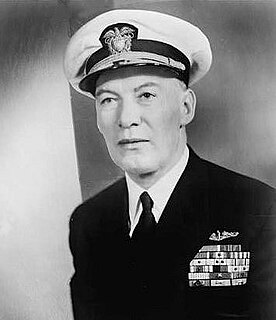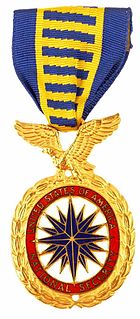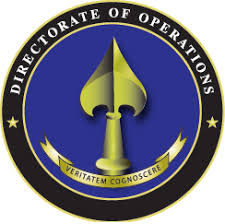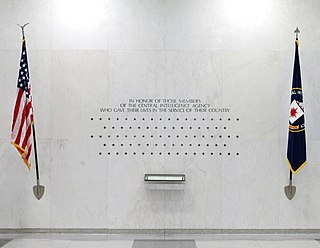
The White House National Security Council (NSC) is the principal forum used by the President of the United States for consideration of national security, military, and foreign policy matters with senior national security advisors and Cabinet officials and is part of the Executive Office of the President of the United States. Since its inception under Harry S. Truman, the function of the Council has been to advise and assist the President on national security and foreign policies. The Council also serves as the President's principal arm for coordinating these policies among various government agencies. The Council has counterparts in the national security councils of many other nations.

The National Security Act of 1947 was a law enacting major restructuring of the United States government's military and intelligence agencies following World War II. The majority of the provisions of the Act took effect on September 18, 1947, the day after the Senate confirmed James Forrestal as the first Secretary of Defense.

Roscoe Henry Hillenkoetter was the third director of the post–World War II United States Central Intelligence Group (CIG), the third Director of Central Intelligence (DCI), and the first director of the Central Intelligence Agency created by the National Security Act of 1947. He served as DCI and director of the CIG and the CIA from May 1, 1947, to October 7, 1950, and, after his retirement from the United States Navy, was a member of the board of governors of National Investigations Committee On Aerial Phenomena (NICAP) from 1957 to 1962.

The Director of Central Intelligence (DCI) was the head of the American Central Intelligence Agency from 1946 to 2005, acting as the principal intelligence advisor to the President of the United States and the United States National Security Council, as well as the coordinator of intelligence activities among and between the various U.S. intelligence agencies.

The National Security Medal is a decoration of the United States of America officially established by President Harry S. Truman in Executive Order 10431 of January 19, 1953. The medal was originally awarded to any person, without regard to nationality, for distinguished achievement or outstanding contribution on or after July 26, 1947, in the field of intelligence relating to the national security of the United States.

Sidney William Souers was an American admiral and intelligence expert.

William Harding Jackson was a U.S. civilian administrator, New York lawyer, and investment banker who served as Deputy Director of the Central Intelligence Agency. Jackson also served briefly under President Dwight D. Eisenhower as Acting United States National Security Advisor from 1956 to 1957.

The Director of the Central Intelligence Agency (D/CIA) is a statutory office that functions as the head of the Central Intelligence Agency, which in turn is a part of the United States Intelligence Community. Since February 2017, the D/CIA has been a member of the Cabinet of the United States, as designated by the President of the United States.
The Office of Policy Coordination (OPC) was the covert operation wing of the United States Central Intelligence Agency (CIA). Created as a department of the CIA in 1948, it actually operated independently until October 1950. OPC existed until 1 August 1952, when it was merged with the Office of Special Operations (OSO) to form the Directorate of Plans (DDP).

The Directorate of Operations (DO), less formally called the Clandestine Service, is one of the smallest components of the US Central Intelligence Agency. It was known as the Directorate of Plans from 1951 to 1973; as the Directorate of Operations from 1973 to 2005; and as the National Clandestine Service (NCS) from 2005 to 2015.

The Central Intelligence Agency is a civilian foreign intelligence service of the federal government of the United States, officially tasked with gathering, processing, and analyzing national security information from around the world, primarily through the use of human intelligence (HUMINT). As a principal member of the United States Intelligence Community (IC), the CIA reports to the Director of National Intelligence and is primarily focused on providing intelligence for the President and Cabinet of the United States.
Executive oversight of United States covert operations has been carried out by a series of sub-committees of the National Security Council (NSC).
The Strategic Services Unit was an intelligence agency of the United States government that existed in the immediate post–World War II period. It was created from the Secret Intelligence and Counter-Espionage branches of the wartime Office of Strategic Services.
The Dulles–Jackson–Correa Report was one of the most influential evaluations of the functioning of the United States Intelligence Community, and in particular, the Central Intelligence Agency (CIA). The report focused primarily on the coordination and organization of the CIA and offered suggestions that refined the US intelligence effort in the early stages of the Cold War.
The Eberstadt Report, officially known as the Task Force Report on National Security Organization, was a study conducted by the United States government which evaluated the structure and operations of the United States Department of Defense and United States Intelligence Community. The report was created by the Task Force on National Security Organization, chaired by Ferdinand Eberstadt, from 1948–49 under the Commission on Organization of the Executive Branch of the Government, also known as the First Hoover Commission. The most important findings of the report include recommendations for better cooperation within the US Intelligence Community, improvement in the internal structure and operations of the Central Intelligence Agency (CIA), and the growing need for the development of scientific intelligence in the background of the Cold War. Despite its submission to US Congress, the report was not widely read due to being overshadowed by the Intelligence Survey Group and its report, the Dulles Report.
The Schlesinger Report, originally titled A Review of the Intelligence Community, was the product of a survey authorized by U.S. President Richard Nixon late in 1970. The objective of the survey was to identify and alleviate factors of ineffectiveness within the United States Intelligence Community (IC) organization, planning, and preparedness for future growth. The report, prepared by James Schlesinger, Deputy Director of the Office of Management and Budget (OMB), was submitted to Nixon on 10 March 1971.
At various times since the creation of the Central Intelligence Agency, the Federal government of the United States has produced comprehensive reports on CIA actions that marked historical watersheds in how CIA went about trying to fulfill its vague charter purposes from 1947. These reports were the result of internal or presidential studies, external investigations by congressional committees or other arms of the Federal government of the United States, or even the simple releases and declassification of large quantities of documents by the CIA.
The Boren-McCurdy intelligence reform proposals were two legislative proposals from Senator David Boren and Representative Dave McCurdy in 1992. Both pieces of legislation proposed the creation of a National Intelligence Director. Neither bill passed into law.

The United States Central Intelligence Agency (CIA) was created on July 26, when Harry S. Truman signed the National Security Act of 1947 into law. A major impetus that has been cited over the years for the creation of the CIA was the unforeseen attack on Pearl Harbor, but whatever Pearl Harbor's role, in the twilight of World War II it was considered clear in government circles that there was a need for a group to coordinate government intelligence efforts, and the Federal Bureau of Investigation (FBI), the State Department, and the War Department, and even the Post Office were all jockeying for that new power.
Edwin Kennedy Wright, also known as Pinky. was a career US Army officer and Deputy Director of the US Central Intelligence Agency.









